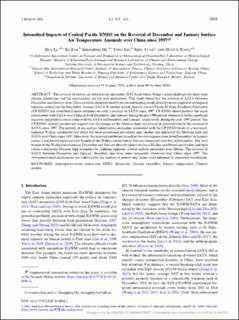| dc.description.abstract | The reversal of surface air temperature anomalies (SATA) in winter brings a great challenge for short-term climate prediction, and the mechanisms are not well understood. This study found that the reversal of SATA between December and January over China could be demonstrated by the second leading mode of multivariate empirical orthogonal function analysis on the December–January SATA. It further reveals that the central Pacific El Niño–Southern Oscillation (CP ENSO) has contributed more influence on such a reversal of SATA since 1997. CP ENSO shows positive but weak correlations with SATA over China in both December and January during the pre-1996 period, whereas it shows significant negative and positive correlations with the SATA in December and January, respectively, during the post-1997 period. The CP ENSO–related circulations suggest that the change of the Siberian high has played an essential role in the reversal of SATA since 1997. The pattern of sea surface temperature anomalies associated with the CP ENSO leads to a westward-replaced Walker circulation that alters the local meridional circulation and, further, has impacted the Siberian high and SATA over China since 1997. Moreover, the seasonal northward march of the convergence zone from December to January causes a northward-replaced west branch of the Walker circulation in January compared with that in December. The west branch of the Walker circulation in December and January directly modulates local Hadley and Ferrel circulations and then causes contrasting Siberian high anomalies by inducing opposite vertical motion anomalies over Siberia. The reversal of SATA between December and January, therefore, has been more frequently observed over China since 1997. The abovementioned mechanisms are validated by the analysis at pentad time scales and confirmed by numerical simulations. | en_US |
